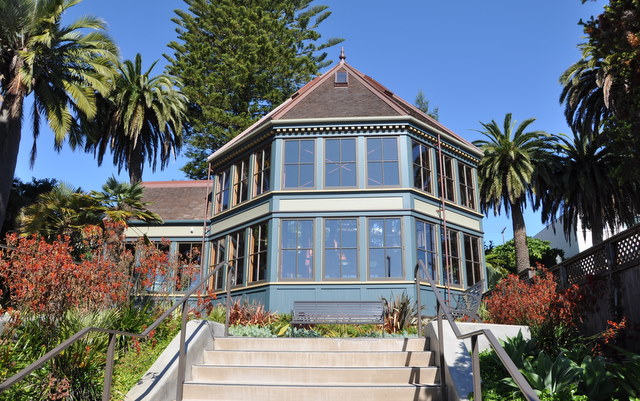This octagonal building is called Sunnyside Conservatory. It is named after the San Francisco district in which it is located-an area that began to develop in 1898 when Behrand Joost subdivided his property. Joost’s Sunnyside Land Company even installed a streetcar line so that owners would have access to downtown.

During this time William Merralls, a British engineer and inventor, came to San Francisco to put his engineering to use in the mining industry. In 1858, Merralls purchased a home at 258 Sunnyside Boulevard (now Monterey Boulevard) that still stands today. He soon began work next door on an eight-sided Victorian-style conservatory to house his growing plant collection and stargazing equipment. When designing the conservatory, he decided on eight sides in order to maximize the natural lighting. The building has a wood shingled two-story center with flanking single-story wings on the east and west.
The property changed hands several times after Merralls’ death, and in 1970 was purchased by developer Robert Anderson. In 1975, due to efforts of the neighborhood, the city designated the conservatory a city landmark. However, because the planning department failed to issue a required Certificate of Appropriateness (a document stating that the proposed work is appropriate to the historic nature of the building and meets local code criteria), Anderson was somehow able to obtain a demolition permit and proceeded to assault the structure. Neighbors alerted the city, and the demolition permit was pulled. Sadly, at that point, 30% of the building had already been torn down.
 Varying colors of concrete represent the planting locations of William Merralls’ era.
Varying colors of concrete represent the planting locations of William Merralls’ era.
In 1980 San Francisco’s Open Space Advisory Committee approved the funds for the Recreation and Parks Department to buy the conservatory and surrounding land. For the next 20 years, the city barely maintained the property, taking minimal steps to keep spontaneous night-time parties and homeless away from the area. Sunnyside Conservatory’s demise was gradual, yet certain.
Restoration-almost entirely from scratch-began in 2001 at a cost of $4.2 million. Materials more appropriate to these times, such as modern heating and plumbing, were mixed with copper and old-growth redwood. The garden, which still contains most of Merralls’ palm trees, was restored as well. It contains a rare Chilean Wine Palm and a century-old Norwalk Pine.
The word conservatory originates from the Italian “conservato,” which simply means to store or to conserve. Originally structures made of stone served this purpose. It isn’t actually known when conservatory builders began using glass, however English writer John Evelyn discussed his glass conservatory in the book Elysium Britannicum (1670). Their popularity grew as wealthy landowners looked for ways to grow the citrus fruit from the Mediterranean that was showing up on their dining tables. The 19th century brought the golden age of conservatory building to England, made possible due to advances in heating technology and glass production. This grand era gave us the Palm House in Kew Gardens and San Francisco’s own Conservatory of Flowers. The building of these extravagant structures ended with the advent of WWII. Insulated glass of the 1950s and ’60s brought about the sunroom structure more common today, and made possible such projects as Biosphere 2 in Oracle, Arizona.

Sunnyside Conservatory is now watched over carefully by the Friends of Sunnyside Conservatory. It is available for private events and community rentals.
 This whimsical door handle is one of many creatures found throughout the property.
This whimsical door handle is one of many creatures found throughout the property.
 Sculpted imaginary creatures by Scott and Ene Constable are scattered throughout the gardens.
Sculpted imaginary creatures by Scott and Ene Constable are scattered throughout the gardens.
Sunnyside Conservatory
236 Monterey Blvd.
San Francisco, CA 94131
The Conservatory Gardens are open from dawn until dusk. The Conservatory building is open for permitted private and community events. For more information, visit the Friends of Sunnyside Conservatory website.






